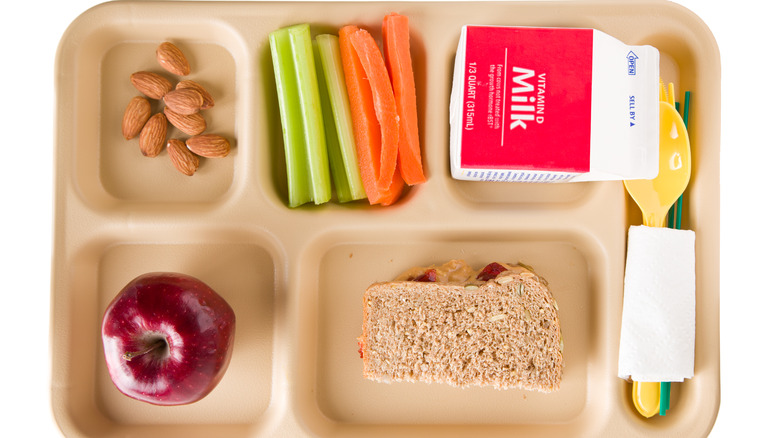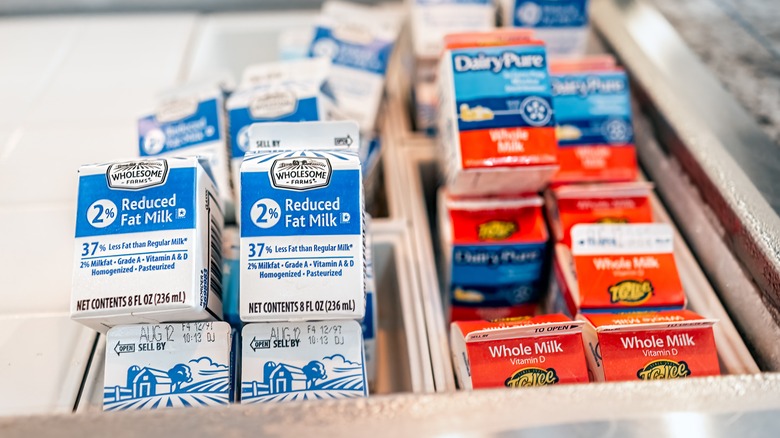Why Schools Serve Lunch With Milk, Not Water
Got milk? Americans sure do, particularly U.S. schoolchildren, who have been served milk with their school lunches for decades. Despite the fact we all know proper hydration is so important, schools do not mandate the serving of water with school kid's lunches, the way they do milk. When so much about the American education system has changed since the days of our grandparents, why does milk still sit on their lunch trays?
The start of milk as a school staple began in the post-WWII years, but was mandated nationwide in 1954 as part of the federal government's program to provide nutrition to students. Per the USDA, schools "must offer fat-free and/or low-fat (1%) unflavored milk as part of school breakfasts and lunches. Schools may also offer fat-free and/or low-fat (1%) flavored milk as an option."
In 1954, the federal government's perspective was twofold: to feed and nourish school kids while also finding a way to use up a surplus of foods and commodities leftover from WWII. Why isn't water shown the same legislative attention as milk?
How and why the US prioritized milk (and not water)
One reason milk was prioritized over water was a result of a surplus created during WWII. Farmers and dairies were encouraged to ramp up their milk production to ship overseas to soldiers. Post-war, there was a massive surplus of milk and no demand to match it, so the U.S. government was forced to come up with a way to use it and so the very first federal subsidized program was enacted in 1940 targeting select schools in Chicago, to offer low-cost or free milk to students.
Over a decade later the Special Milk Program was born in 1955, which put milk in the hands of school kids at recess and lunchtime nationwide. The program stipulated that children would receive a half pint daily, and schools would be reimbursed for the milk they provided. This program has been extended not just to schools but summer camps, childcare programs, pre-K programs, and more.
Water, though it must be made available free of charge under the National School Lunch Act, for schools participating in the National School Lunch Program (per USDA), is not a requirement to have with lunch. And, according to those in the dairy industry, milk is prioritized over water in cafeterias to help school kids meet their daily nutritional needs for calcium and vitamin D, among 13 other essential nutrients.
The future of milk and water in our schools
For nearly a century, milk has remained a staple in schools, even as milk consumption plummets nationwide. Changes in drinking habits and the rise of plant-based alternatives have contributed to this downturn over the past seven decades. Despite 30-50 million Americans being lactose intolerant, with rates at 90% in Asian Americans and 80% in African Americans, the school milk program remains (per Boston Children's Hospital).
Bills regarding the U.S. school's milk requirements continue through Congress. One such effort is trying to reduce the sugar content in school milk — now often flavored and sweetened. In addition, the Whole Milk for Healthy Kids Act was passed in December of 2023, which allows 2% and whole milk back into the school lunch offerings, after it was previously removed by the Obama administration in response to rising childhood obesity.
Though schools must make water available, this doesn't mean water in schools is subject to the same regulation as milk. Not only is it not a requirement, more than 50% of U.S. states have no regulations to test water for safety. This means in many cases, water may be unsafe to drink. Concerns have been raised about higher than safe levels of lead in many schools, due to unknown numbers of old lead pipes feeding the schools.


